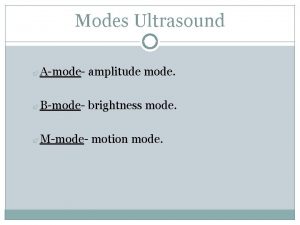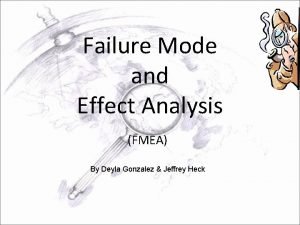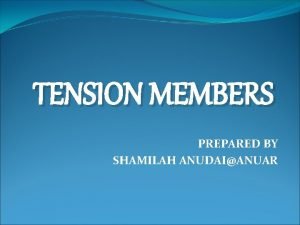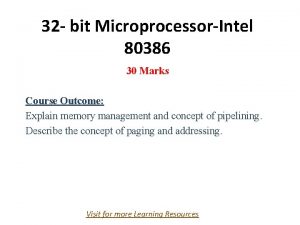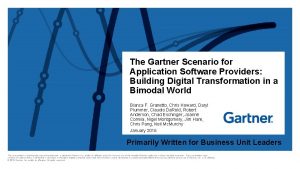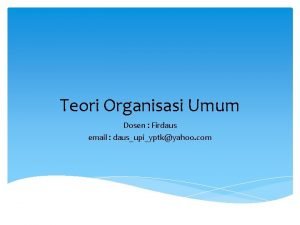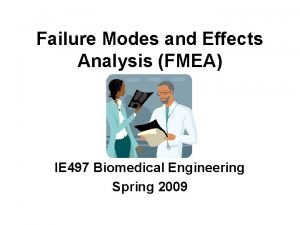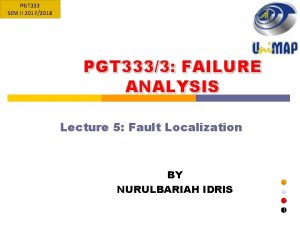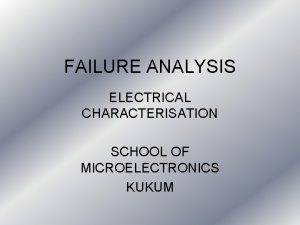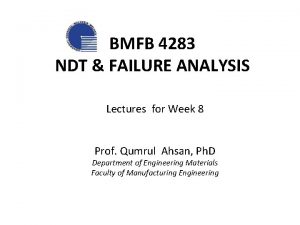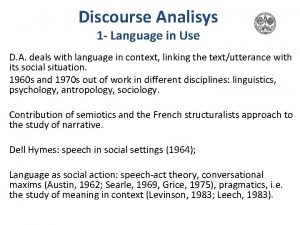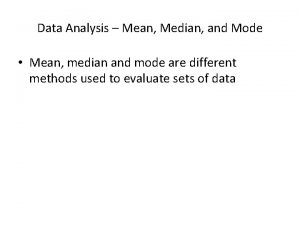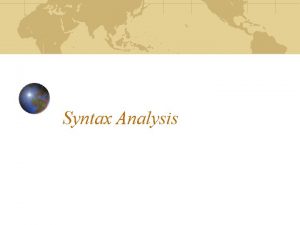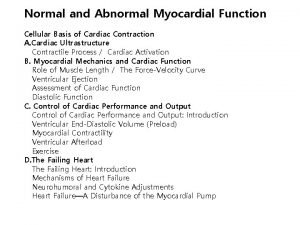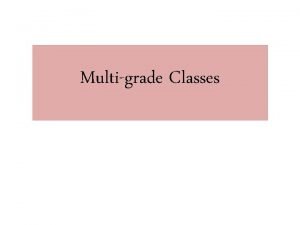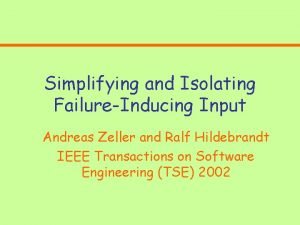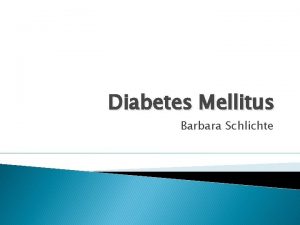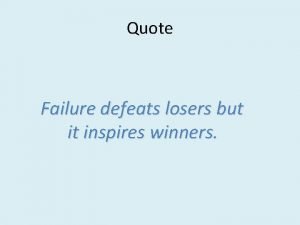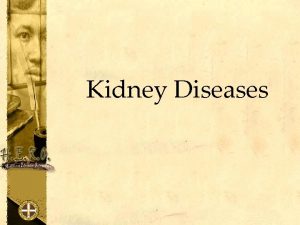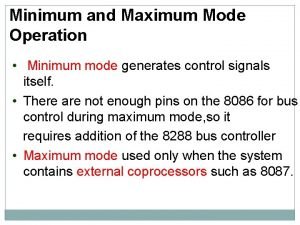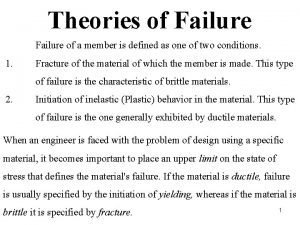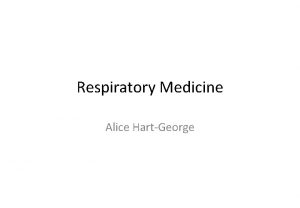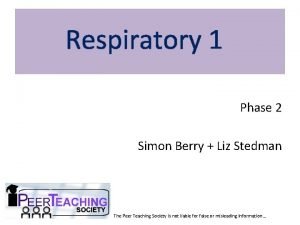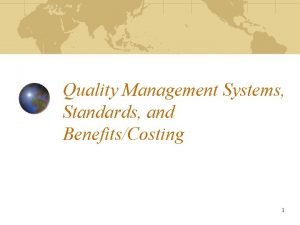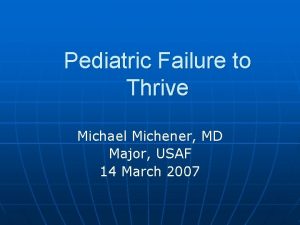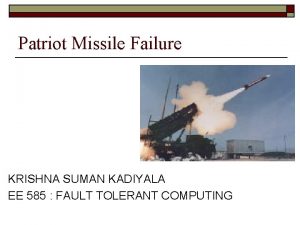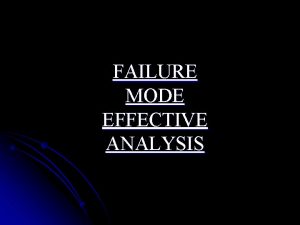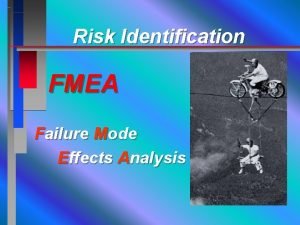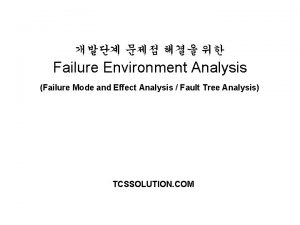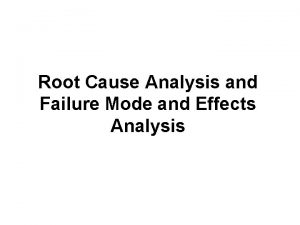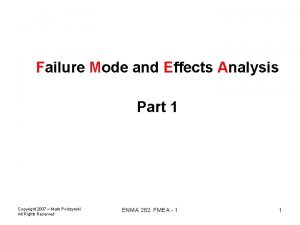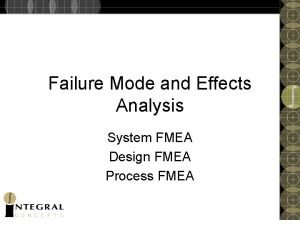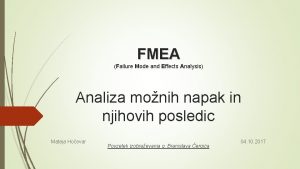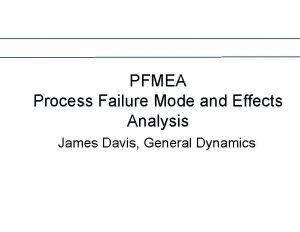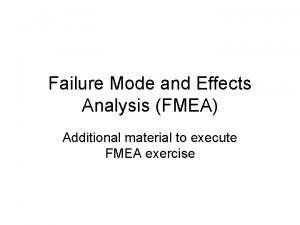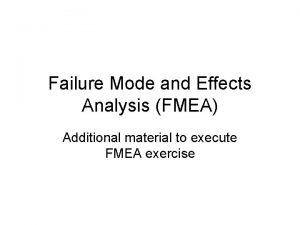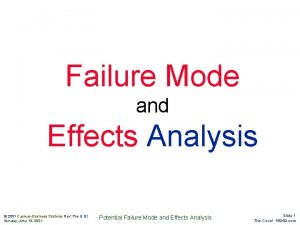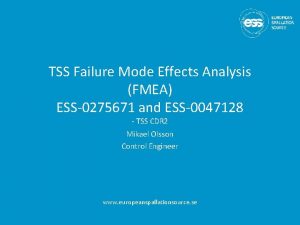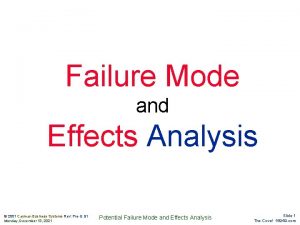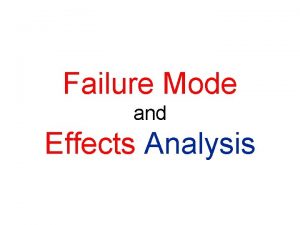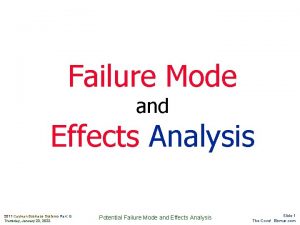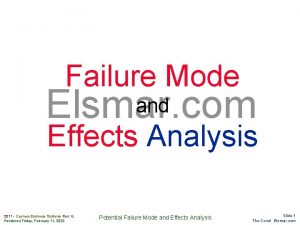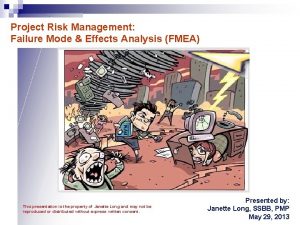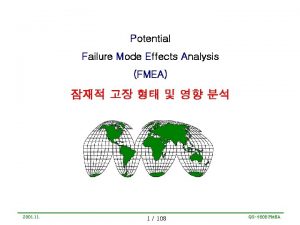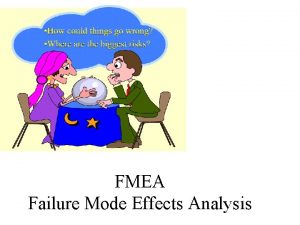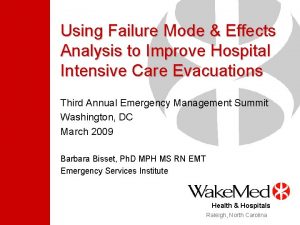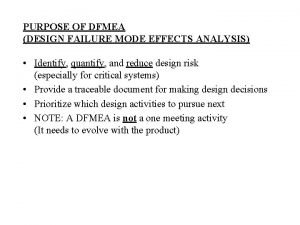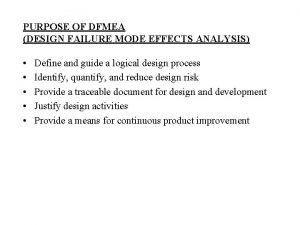Welcome Day 1 Failure Mode and Effects Analysis







































































- Slides: 71

Welcome -- Day 1 Failure Mode and Effects Analysis 1. 1

FTEP Modules Quick QFD Systems Engineering Fundamentals Global 8 D Process Control Methods Ford Technical Education Program FMEA Experimental Design Reliability Tolerance Design Parameter Design 1. 2

Warm-Up -- Day 1 Place Self Others Purpose Team Agenda 1. 3

Course Purpose These three days are designed to. . . help you function effectively as an FMEA team member, but not to leave as an FMEA team leader or an FMEA expert 1. 5

Participant Materials Questionnaire v v Only one correct answer is possible Do NOT guess if unsure of answer 1. 6

FMEA -- An Introduction v Day 1 Introduction v v Why Do FMEAs? Definition, Purpose, Types, Benefits FMEA Working Model Generating / Managing Team Approach 1. 7

Ford 2000 Strategies Empowered People Achieve Worldwide Growth Nimble Through Process Leadership Ford Lead in Customer Satisfaction Lead in Corporate Citizenship The World’s Leading Automotive Company Achieve Worldwide Product Excellence The Low Cost Producer 1. 8

1. 9

Why Do FMEAs? v v Appropriate recommended actions may not have been taken Significant savings in engineering time -- reduction in changes immediately before and after Job 1 1. 10

FMEA -- Definition Structured group of activities which. . . v v 2 -2 v Recognize and evaluate the potential failure of a product or process and its effects Identify actions which could eliminate or reduce the chance of the potential failure occurring Document the process 1. 11

Failures FMEA Purposes Origin of Failures Elimination of Failures FMEA JOB 1 Time 1. 12

Customer Orientation QFD FMEA Purposes Unreliable Products Excellent Products Disaster Reliable Products Customer Doesn't Want Design and Process Orientation FMEA 1. 13

FMEA -- Purposes FMEAs are intended to. . . v v 2 -2 Identify potential failure modes and rate severity of effects Identify critical and significant characteristics Help engineers prioritize and focus on eliminating product and process concerns and helps prevent problems from occurring Test adequacy of controls from DCP process 1. 14

FMEA -- Types System Concept FMEA Design FMEA Sub-System Component System Process FMEA Assembly Sub-System Component System Manufacturing Sub-System Component 2 -4 1. 15

Benefits -- Concept FMEAs Design Concept Process v v v 2 -5 Helps select optimum concept Identifies potential failure modes Considers potential effects Helps generate occurrence ratings Identifies testing requirements Helps determine if hardware system redundancy is required 1. 16

Benefits -- Design FMEAs Design Concept Process v v v 2 -5 v Aids in evaluating requirements and alternatives Aids in initial design for DFM Increases probability of detecting failure modes and their effects Provides additional information for testing requirements Helps identify critical and significant characteristics 1. 17 Helps validate DVPs and SDSs

Benefits -- Process FMEAs Design Concept Process v v 2 -6 v Identifies potential product related failure modes Assesses effects on all customers Identifies potential Manufacturing and Assembly causes to focus controls on reducing occurrence and/or increasing detection Establishes a priority system for considering corrective actions Identifies confirmed critical and significant characteristics 1. 18

FMEA Working Model Potential Failure Mode and Effects Analysis ___ System ___ Subsystem ___ Component Model Year / Vehicle(s): Core Team: Item Function Potential Failure Mode FMEA Number: Page 1 of 1 Prepared by: FMEA Date ( Orig): Design Responsibility: Key Date: Potential Effect(s) of Failure S e v C l a s s Potential Cause(s)/ Mechanisms Failure O c c u r Current Design Controls D e t e c R P N Recommended Action(s) Responsibility & Target Completion Date (Rev) Action Results S O e c Actions v c Taken D R e P t N 1. 19

Generating FMEAs Who initiates? When to discard? How is FMEA documented? When is FMEA complete? 2 -9 Who prepares? Who updates? Failure Mode and FMEAs Effects Analysis Who is FMEA customer? When started and updated? Relationship to FPDS? 1. 20

Managing FMEAs are living documents, and are updated when. . . v v v Modification to a component, process or system is planned Component is to be used in new environment Customer concern arises: Global 8 D 1. 21

FMEAs and Systems Engineering Customer Musts / Wants CFMEA Vehicle Level Inputs Customer Requirements • Purchaser / owner / operator • Regulatory (FMVSS, EPA, . . . ) • Corporate (WCR, ABS, Manuf, . . . ) Purchase, Operate & Maintain Disposal Feasibility Feedback Requirements Cascade Vehicle Level Requirements • Vehicle Attributes • Vehicle System Specification - VDS DFMEA Customer Satisfaction Customer Focus Customer Experience & Feedback Vehicle Verification DVM / DVP Production Feasibility Feedback Requirements Cascade System / Subsystem Level • System & • Subsystem Design Specifications SDS DVM / DVP System Verification Feasibility Feedback Requirements Cascade PFMEA Part / Component Fabrication / Part/ Verification Component Design • Component Design Specification - CDS 2 -13 KO SI SC PA PR J 1 1. 22

Team Approach -- FMEA Core Team 3 -5 Support Team 1. 23

Section Summary v Day 1 Introduction v v Why Do FMEAs? Definition, Purpose, Types, Benefits FMEA Working Model Generating / Managing Team Approach 1. 24

Break 1. 25

Design FMEA -- An Introduction Day 1 Design FMEA Introduction v Identify FMEA Team v Establish Scope v Describe Function » Brainstorming » Function Trees v Practice Exercise 1 1. 26

Design FMEA Potential Failure Mode and Effects Analysis Scope Team ___ System ___ Subsystem ___ Component Model Year / Vehicle(s): Core Team: Item Function Potential Failure Mode Potential Effect(s) of Failure S e v C l a s s Potential Cause(s)/ Mechanisms Failure FMEA Number: Page 1 of 1 Prepared by: FMEA Date ( Orig): Design Responsibility: Key Date: O c c u r Current Design Controls D e t e c R P N Recommended Action(s) Responsibility & Target Completion Date (Rev) Action Results S O e c Actions v c Taken D R e P t N 1. 27

Design FMEA -- Team Facilitator or Application Engineer Technical Affairs Design Engineer Manufacturing / Process Engineer 3 -5 Representatives from: Support Team • Customer Service CORE Team • Suppliers • Global Test Operations • Corporate Quality 1. 28

Design FMEA -- Scope Once core team is established. . . v v v 3 -8 Create a block diagram Identify the boundary for analysis Confirm composition of the support team 1. 29

Constructing Block Diagrams Assembly Service Part X Screw Component/ Assembly User 3 -10 Other Systems Adhesive Weld Part Z Part Y 1. 30

Block Diagram -- Example Headlamp Assembly 1. 31

Block Diagram -- Example Vertical Trimmer Assembly 1. 32

Block Diagram -- Example Hood (Clearance) Vehicle Body Upper Cross Member Lateral Location Screw Adjuster Socket Vertical Trimmer Assembly User Clips 2 Reflector 1. 33

Determine Function Potential Failure Mode and Effects Analysis Scope Team ___ System ___ Subsystem ___ Component Model Year / Vehicle(s): Core Team: Item Function Potential Failure Mode Potential Effect(s) of Failure S e v C l a s s Potential Cause(s)/ Mechanisms Failure FMEA Number: Page 1 of 1 Prepared by: FMEA Date ( Orig): Design Responsibility: Key Date: O c c u r Current Design Controls D e t e c R P N Recommended Action(s) Responsibility & Target Completion Date (Rev) Action Results S O e c Actions v c Taken D R e P t N 1. 34

What is Function ? v v v 5 -6 Design intent or engineering requirement Must be measurable or set at an actionable level Representation of all wants, needs and requirements, both spoken and unspoken 1. 35

Describe Function Verb Indicates action, occurrence, being 5 -7 Generate Control Dispense Retain Prevent Noun Indicates what the action relates to Light Speed Fuel Seat Track Rust 1. 36

Describe Function Thought Starters. . . v v v Satisfy user Attract user Assure convenience Assure dependability Governmental requirements Safety requirements 1. 37

Brainstorming Exercise in creative thinking Method to generate ideas 1. 38

Brainstorming -- Guidelines v Warm up v Suspend judgment v Anything goes v Quantity counts v Springboard v Persevere v Warm down 1. 39

Brainstorming -- Pitfalls v Low team trust v Broad task definition v Criticism, competition, defensiveness v Silliness, lack of focus v Questions and explanations v Organizing ideas during creative stage 1. 40

Brainstorming -- Agreement v Everyone explains view(s) v Identify needs of individuals v If you can’t meet a need, say so v Check out feelings -- yours / others v Don’t compromise, average, or ‘split the difference’ 1. 41

Function Trees v v v Provide an organized approach to identify the essential features of a product (or process sometimes) Help ensure that ‘unspoken’ and ‘spoken’ requirements are defined Provide a graphical representation of functions to ensure clear, total team understanding 1. 42

Constructing Function Trees HOW ? WHY ? Secondary Level Primary Level Tertiary Level 1. 43

Vertical Trimmer Function Tree HOW ? Permit / Maintain Horizontal Adjustment Adjust Headlamp WHY ? Adjust Light Beam X° Both Directions Locate Headlamp Laterally 10 Years, 150, 000 Miles Retain Setting 10 Years, 150, 000 Miles Permit / Maintain Vertical Adjustment Retain Setting 10 Years, 150, 000 Miles Adjust Light Beam X° Both Directions Locate Headlamp Vertically 10 Years, 150, 000 Miles 1. 44

Guidelines v v v Brainstorm all functions (VERB - NOUN) Document individual functions by asking “HOW is function achieved? ” Repeat left to right, until actionable level Use worksheet to check that actionable level is measurable Work right to left and check structure by asking “WHY is function included? ” 1. 45

Practice Exercise 1 Block diagram Brainstorming Function Tree 1. 46

1. 47

Presentation -- Practice 1 Technical Debrief Team Debrief 1. 48

Design FMEA Functions Potential Failure Mode and Effects Analysis ___ System ___ Subsystem ___ Component Model Year / Vehicle(s): Core Team: Item Potential Failure Mode FMEA Number: Page 1 of 1 Prepared by: FMEA Date ( Orig): Design Responsibility: Key Date: Potential Effect(s) of Failure Function S e v C l a s s Potential Cause(s)/ Mechanisms Failure O c c u r Current Design Controls D e t e c R P N Recommended Action(s) Responsibility & Target Completion Date (Rev) Action Results S O e c Actions v c Taken D R e P t N Function 1 Function 2 Function 3 Function n Function Sub-Sub. Function 1. 49

Section Summary Day 1 Design FMEA Introduction v Identify FMEA Team v Establish Scope v Describe Function » Brainstorming » Function Trees v Practice Exercise 1 1. 50

Design FMEA Path 1 Day 1 DFMEA -- Path 1 v Failure Modes v Effects -- Severity v Recommended Actions v Potential Special Characteristics v Practice Exercise 2 1. 51

Design FMEA -- Path 1 Potential Failure Mode and Effects Analysis ___ System ___ Subsystem ___ Component Model Year / Vehicle(s): Core Team: Item Function Potential Failure Mode FMEA Number: Page 1 of 1 Prepared by: FMEA Date ( Orig): Design Responsibility: Key Date: Potential Effect(s) of Failure S e v C l a s s Potential Cause(s)/ Mechanisms Failure O c c u r Current Design Controls D e t e c R P N Recommended Action(s) Responsibility & Target Completion Date (Rev) Action Results S O e c Actions v c Taken D R e P t N 1. 52

Potential Failure Modes Potential Failure Mode and Effects Analysis ___ System ___ Subsystem ___ Component Model Year / Vehicle(s): Core Team: Item Function Potential Failure Mode FMEA Number: Page 1 of 1 Prepared by: FMEA Date ( Orig): Design Responsibility: Key Date: Potential Effect(s) of Failure S e v C l a s s Potential Cause(s)/ Mechanisms Failure O c c u r Current Design Controls D e t e c R P N Recommended Action(s) Responsibility & Target Completion Date (Rev) Action Results S O e c Actions v c Taken D R e P t N Function 1 Function 2 Function 3 Function 4 Function n 5 -8 Potential Failure Modes: • No function • Partial function • Intermittent function • Unintended function 1. 53

Potential Failure Modes Failure Mode Type Potential Failure Mode No function Not operational Partial function Not all of function operating Intermittent function Occasionally does not function Unintended function Unexpected function occurs 3 -21 1. 54

Failure Modes -- Vertical Trimmer Failure Mode: Adjust Light Beam X° in Both Directions Failure Mode Type Potential Failure Mode No function No adjustment Partial function Adjustment in one direction Intermittent function Adjustment sometimes and not at others Unintended function Trimmer itself produces light 1. 55

Effects of Failure Modes Potential Failure Mode and Effects Analysis ___ System ___ Subsystem ___ Component Model Year / Vehicle(s): Core Team: Item Function 5 -10 Potential Failure Mode FMEA Number: Page 1 of 1 Prepared by: FMEA Date ( Orig): Design Responsibility: Key Date: Potential Effect(s) of Failure S e v C l a s s Potential Cause(s)/ Mechanisms Failure O c c u r Current Design Controls D e t e c R P N Recommended Action(s) Responsibility & Target Completion Date (Rev) Action Results S O e c Actions v c Taken D R e P t N 1. 56

Effects of Failure Modes Potential Failure Mode and Effects Analysis ___ System ___ Subsystem ___ Component Model Year / Vehicle(s): Core Team: Item Potential Failure Mode Potential Effect(s) of Failure Function 1 FMEA Number: Page 1 of 1 Prepared by: FMEA Date ( Orig): Design Responsibility: Key Date: S e v C l a s s Potential Cause(s)/ Mechanisms Failure O c c u r Current Design Controls D e t e c R P N Recommended Action(s) Responsibility & Target Completion Date (Rev) Action Results S O e c Actions v c Taken D R e P t N Failure Mode 1 Failure Mode n Potential Effects of Failure Modes: Function 2 Function n 5 -11 • • • Part / Sub-component Assembly System Vehicle Government Regulations Customer (Internal and End User) 1. 57

Design FMEA -- Effects Table Vertical Trimmer Failure Mode Doesn’t Retain Setting Part / SC Assbly System Vehicle Gov’t Custmr Trimmer Headlamp Lt System (-) Regs Driver May Be Stripped By Adjustment Attempt Cannot be Adjusted Misaligned Lightbeam Impaired Night/Fog Perforsmanc e Road Vehicle Light Regs ‘ 89 F/CMVSS Non. Compliance Impaired Night/Fog Vision 1. 58

Design FMEA -- Severity Potential Failure Mode and Effects Analysis ___ System ___ Subsystem ___ Component Model Year / Vehicle(s): Core Team: Item Function 5 -13 Potential Failure Mode FMEA Number: Page 1 of 1 Prepared by: FMEA Date ( Orig): Design Responsibility: Key Date: Potential Effect(s) of Failure S e v C l a s s Potential Cause(s)/ Mechanisms Failure O c c u r Current Design Controls D e t e c R P N Recommended Action(s) Responsibility & Target Completion Date (Rev) Action Results S O e c Actions v c Taken D R e P t N 1. 59

Suggested Severity Evaluation Criteria Effect Criteria: Severity of Effect Ranking Hazardous Without Warning . . . affects safe vehicle operation and/or government regulation without warning 10 Hazardous With Warning . . . affects safe vehicle operation and/or government regulation with warning 9 Low … operable at reduced level of performance. Customer experience some dissatisfaction 5 None No Effect 1 1. 60

DFMEA Severity Rating Example Item Function Vertical Trimmer/ Retains Setting Potential Failure Mode Does not maintain adjustment S E V Potential Effects of Failure Part: May be stripped during adjustment (7) Assembly: Headlamp cannot be adjusted (6) System: Misaligned lightbeam (8) Vehicle: Impaired night/fog performance (7) Govt Regs: Non-compliance (10) Customer: Impaired night/ fog (7) 10 1. 61

DFMEA -- Recommended Actions Potential Failure Mode and Effects Analysis ___ System ___ Subsystem ___ Component Model Year / Vehicle(s): Core Team: Item Function 5 -32 Potential Failure Mode FMEA Number: Page 1 of 1 Prepared by: FMEA Date ( Orig): Design Responsibility: Key Date: Potential Effect(s) of Failure S e v C l a s s Potential Cause(s)/ Mechanisms Failure O c c u r Current Design Controls D e t e c R P N Recommended Action(s) Responsibility & Target Completion Date (Rev) Action Results S O e c Actions v c Taken D R e P t N 1. 62

Select and Manage Actions To Reduce: Severity 3 -37 Consider This Action: Change the design. . . To Accomplish This: Eliminate failure mode(s). . . 1. 63

Identify Potential Special Characteristics Design FMEA S=9 S=10 YC 7 -11 1. 64

Practice Exercise 2 Failure Modes Effects Severity Recommended Actions Classifications 1. 65

Break 1. 66

Managing FMEAs FMEAplus 1. 67

Presentation -- Practice 2 Technical Debrief Team Debrief 1. 68

Section Summary Day 1 DFMEA -- Path 1 v Failure Modes v Effects -- Severity v Recommended Actions v Potential Special Characteristics v Practice Exercise 2 1. 69

Warm-Down -- Day 1 Place Self Purpose Others Team Agenda 1. 70

Course Purpose These three days are designed to. . . help you function effectively as an FMEA team member, but not to leave as an FMEA team leader or an FMEA expert 1. 71

Day 1 Failure Mode and Effects Analysis 1. 72
 Day 1 day 2 day 3 day 4
Day 1 day 2 day 3 day 4 B mode image
B mode image Failure mode and effect analysis
Failure mode and effect analysis Failure to capture vs failure to sense ecg
Failure to capture vs failure to sense ecg Vvi pacemaker
Vvi pacemaker Ductile fracture mechanism
Ductile fracture mechanism Day 1 day 2 day 817
Day 1 day 2 day 817 Gross section yielding failure
Gross section yielding failure Focus mode and diffuse mode
Focus mode and diffuse mode Real protected and virtual modes of 80386
Real protected and virtual modes of 80386 8088 data bus
8088 data bus Mode địa chỉ tức thì là mode
Mode địa chỉ tức thì là mode Operating modes of 8051
Operating modes of 8051 Gartner mode 1 mode 2
Gartner mode 1 mode 2 Perbedaan (planning mode) dan (evolutionary mode)
Perbedaan (planning mode) dan (evolutionary mode) Wise men three clever are we
Wise men three clever are we Failure point analysis
Failure point analysis Photo emission microscopy failure analysis
Photo emission microscopy failure analysis Curve tracing failure analysis
Curve tracing failure analysis Ndt failure analysis
Ndt failure analysis Romeo and juliet timeline sunday through thursday
Romeo and juliet timeline sunday through thursday Welcome to day 2
Welcome to day 2 Welcome back day 2
Welcome back day 2 Joinmyquiz.cmo
Joinmyquiz.cmo Field tenor and mode in discourse analysis
Field tenor and mode in discourse analysis William beanes elementary school
William beanes elementary school Oceans apart day after day meaning
Oceans apart day after day meaning Day to day maintenance
Day to day maintenance As your room gets messier day by day, entropy is
As your room gets messier day by day, entropy is Tomorrow i dont know
Tomorrow i dont know Growing day by day
Growing day by day Seed germination inhibitors examples
Seed germination inhibitors examples Seed germination conclusion
Seed germination conclusion Role of transpiration
Role of transpiration I live for jesus day after day
I live for jesus day after day One day casting crowns
One day casting crowns Day one day one noodle ss2
Day one day one noodle ss2 Dayone ss2
Dayone ss2 Mean median mode data analysis
Mean median mode data analysis Discourse modes
Discourse modes Panic mode recovery in lexical analysis
Panic mode recovery in lexical analysis Principles of information security 5th edition pdf
Principles of information security 5th edition pdf Forrester classification heart failure
Forrester classification heart failure Stigma associated with failure and repetition is removed
Stigma associated with failure and repetition is removed Ddmin
Ddmin Factors of project success and failure
Factors of project success and failure Inverted organizational pyramid
Inverted organizational pyramid Chlorpromide
Chlorpromide Diabetes and heart failure
Diabetes and heart failure Failure defeats losers and inspires winners
Failure defeats losers and inspires winners Kidney failure and foamy urine pictures
Kidney failure and foamy urine pictures Cycle of failure mediocrity and success
Cycle of failure mediocrity and success Causes and effects of the french and indian war
Causes and effects of the french and indian war 8288 is used in which mode
8288 is used in which mode Maximum distortion energy theory
Maximum distortion energy theory Failure to fire pacemaker
Failure to fire pacemaker Example of encoding failure
Example of encoding failure Earthy look in chronic renal failure
Earthy look in chronic renal failure Respiratory failure type 1
Respiratory failure type 1 Blue bloater vs pink puffer
Blue bloater vs pink puffer Internal failure costs examples
Internal failure costs examples Example of encoding failure
Example of encoding failure It project failure case study
It project failure case study Failure to thrive definition
Failure to thrive definition Patriot missile failure case study
Patriot missile failure case study Patriot missile failure
Patriot missile failure Urinalysis
Urinalysis Example of encoding failure
Example of encoding failure Define market failure
Define market failure The failure of the league of nations.
The failure of the league of nations. Classification of ejection fraction
Classification of ejection fraction Power by andrew forster
Power by andrew forster

